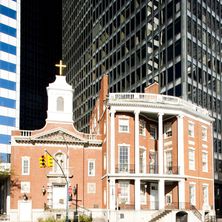

Although technically this attractive architectural complex functions as one unit, in reality it is composed of two separate edifices. And not only are they separate edifices; they were also built in two different centuries, about 150 years apart.
The building to the right of the church is known as the James Watson House. It originally belonged to James Watson, Speaker of the New York State Assembly at the end of 18 th century, and US Senator from New York for the following two years. The house was built in the Federal style, which often reintroduced Ancient Greek and Roman motifs. Several years later the house was expanded. After the American Civil War it was bought by Irish author and philanthropist Charlotte Grace O'Brien, who transformed it into the Mission of Our Lady of the Rosary, a hospice for immigrant girls.
The building on the left is the Church of Our Lady of the Holy Rosary, a Roman Catholic Church that was built in 1965 in Colonial Revival style, perfectly matching the texture, color and overall appearance of the adjacent building. The church contains the shrine of Elizabeth Ann Seton, the first native-born American to be canonized by the Roman Catholic Church. Elizabeth was born in 1774 in a prominent, Episcopal family and after travelling with her husband to Italy, where he died of yellow fever, she converted to Catholicism. Upon return to the US she established a religious community and dedicated the rest of her life to caring for the poor and ill. She was pronounced saint in 1975 by Pope Paul VI. Although Elizabeth lived in the house standing adjacent to the church, her remains are interred in the State of Maryland, where she lived the last years of her life.